SSZT412 September 2019 TPS563201 , TPS563249 , TPS568215
Multilayer ceramic capacitors (MLCCs) are popular in electronic circuits, particularly for decoupling power supplies, but have become harder to procure due to a severe market shortage of MLCCs in larger case sizes, which began in 2018. Market indicators show that nothing will change until at least 2020. Consequently, designers are now seeking ways to reduce the number of MLCCs in DC/DC switching regulators.
One option to minimize the MLCC count for DC/DC switching regulators is to select a device capable of operating with fewer external capacitors. Another option is to choose a DC/DC switching regulator with TI’s D-CAP+™ control mode. Increasing the switching frequency will also help reduce capacitor count. For example, increasing the switching frequency of the TPS563201 from 580 kHz to 1.4 MHz led to the design of the TPS563249, which has one less capacitor.
The option for reducing the MLCC count for DC/DC regulators studied in this article considers the use of a replacement technology. The most common types of replacement technologies are film, aluminum (liquid and polymer), and tantalum (solid and polymer). There are pros and cons of each technology, including their capacitance, voltage range, equivalent series resistance (ESR), size, and current rating. When selecting capacitors for DC/DC switching regulators, ESR is usually the biggest differentiating factor because the higher it is the more output-voltage ripple, heating, and input noise occur, which is why MLCCs are popular for DC/DC switching regulators since they most often have the lowest ESR. Aluminum polymer capacitors share several characteristics with MLCCs and have a low enough ESR to be a replacement for MLCCs amongst designers. As you can see in Figure 1, aluminum polymer capacitors are the type of capacitors that have the closest ESR values to MLCCs.
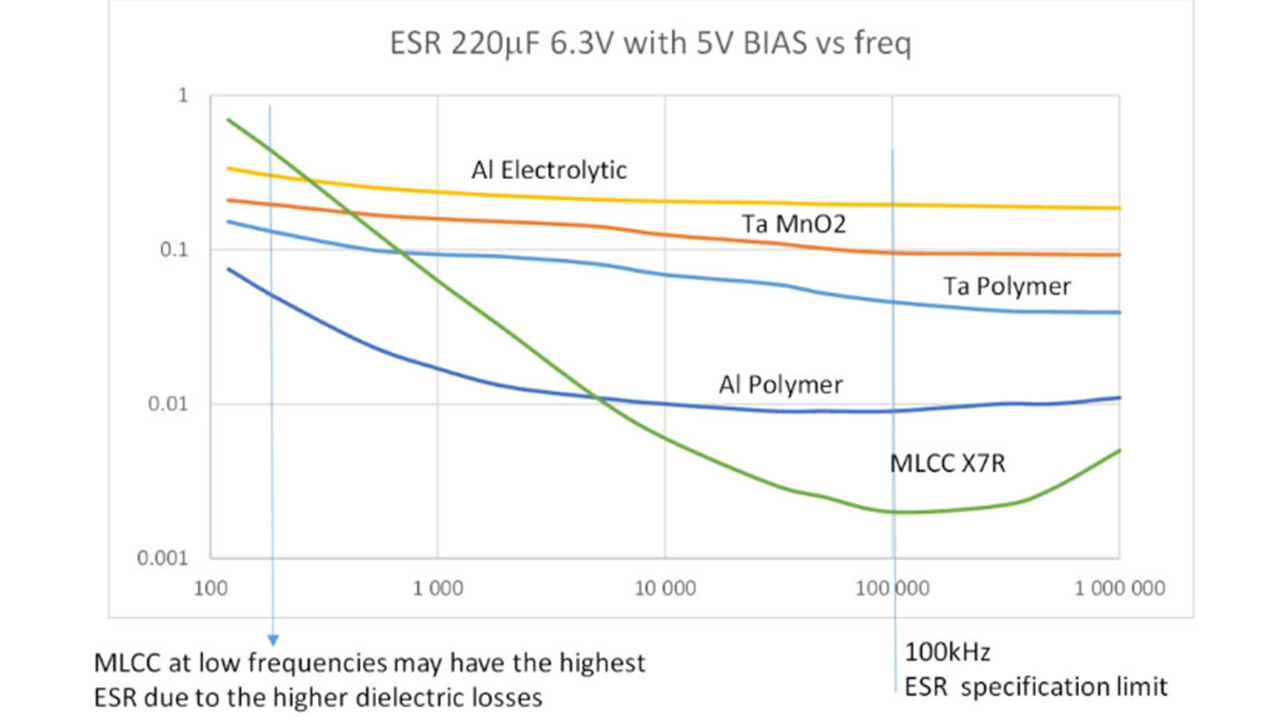 Figure 1 ESR of Various Capacitor
Technologies (Source: Why low ESR matters in capacitor
design)
Figure 1 ESR of Various Capacitor
Technologies (Source: Why low ESR matters in capacitor
design)One downside of aluminum polymer capacitors is that they are bigger than MLCCs. When using the WEBENCH® Power Designer tool, which provides printed circuit board (PCB) layout information, you can see in Figure 2 that if you replace the five output MLLCs of the TPS568215 synchronous buck converter with one aluminum polymer capacitor, both solutions occupy similar surface areas.
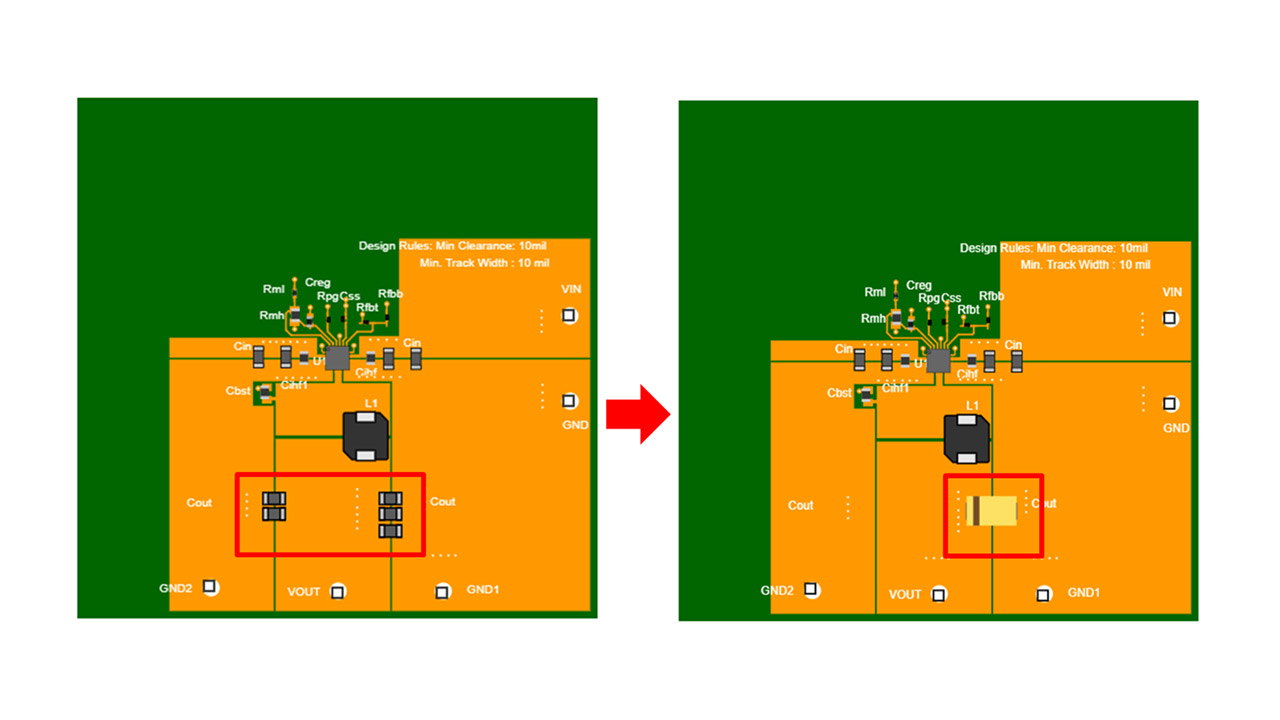 Figure 2 Replacing MLCCs with an
Aluminum Polymer Capacitor for the TPS568215 in the WEBENCH Power Designer
Tool
Figure 2 Replacing MLCCs with an
Aluminum Polymer Capacitor for the TPS568215 in the WEBENCH Power Designer
ToolThe question now comes down to performance. How do aluminum polymer capacitors compare to MLCCs, and can they truly replace MLCCs without forcing designers to make too many compromises?
To get a rough idea, I used the WEBENCH Power Designer tool to simulate some load transient responses. As shown in Figure 3, using an aluminum polymer capacitor at the output instead of the MLCCs increases the output voltage ripple tenfold. Thus, replacing MLCCs with only aluminum polymer capacitors is not a feasible option if you need decent performance.
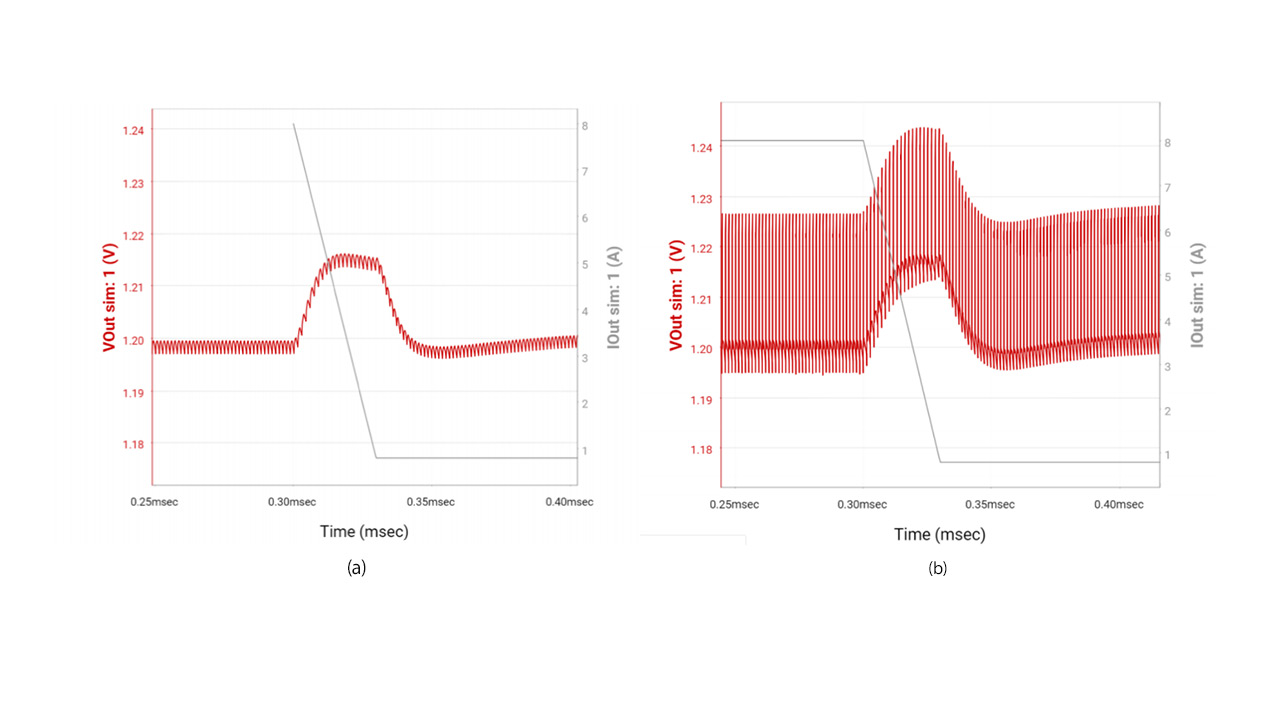 Figure 3 Load Transient Simulations Run
on the WEBENCH Power Designer Tool for the TPS568215 with Output MLCCs (a); and
Aluminum Polymer Capacitors (b)
Figure 3 Load Transient Simulations Run
on the WEBENCH Power Designer Tool for the TPS568215 with Output MLCCs (a); and
Aluminum Polymer Capacitors (b)What about combining MLCCs and aluminum polymer capacitors to help reduce the voltage ripple while minimizing the ceramic count on DC/DC switching regulators? To determine that, I performed some real PCB testing with the TPS568215 evaluation module (EVM). The strategy was first to run some tests on the initial configuration of the EVM to validate the test setup by comparing the input voltage ripple, output voltage ripple, load transient response, start up response, and shut down response with the ones from the datasheet. Then, I tried out different capacitor configurations both at the input and output of the EVM.
The two setups that showed the closest results to the initial configuration were using a mix of aluminum polymer capacitors and MLCCs, as shown in Figure 4, where the setup in Figure 4a tested the output voltage ripple and the setup in Figure 4b tested the input voltage ripple.
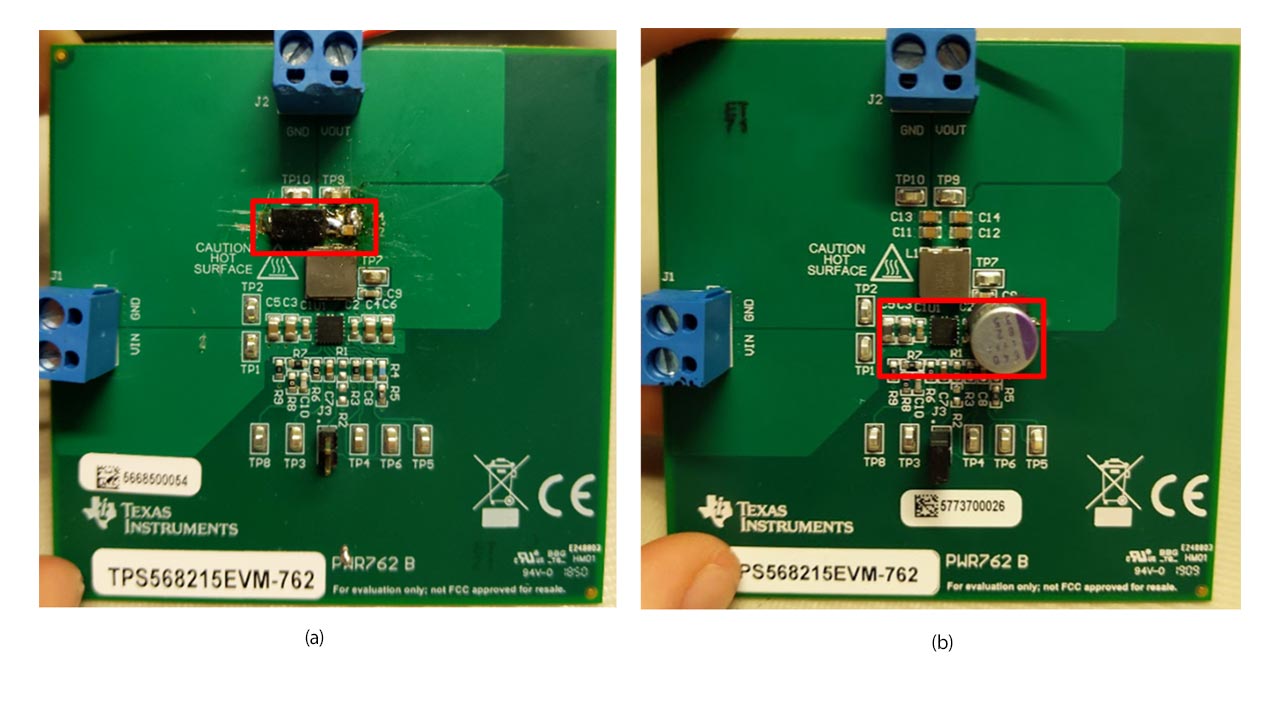 Figure 4 TPS518215EVM Setup with One
Aluminum Polymer Capacitor in Parallel with One MLCC at the Output (a); One
Aluminum Polymer Capacitor in Parallel with Three MLCCs at the Input (b)
Figure 4 TPS518215EVM Setup with One
Aluminum Polymer Capacitor in Parallel with One MLCC at the Output (a); One
Aluminum Polymer Capacitor in Parallel with Three MLCCs at the Input (b)The tests were performed with a 12-V input and an 8-A load. It was not surprising to see an increase in voltage ripple for both the input and output, but a smaller one than when using only aluminum polymer capacitors. The output voltage ripple went from 8 mV to 14 mV, as you can see in Figure 5, while the input voltage ripple went from 13 mV to 24 mV, as you can see in Figure 6.
Looking at the ESR values of the original capacitor configuration versus the hybrid configuration explains why this occurred. For the input setup, the total ESR when using four MLCCs in parallel is 0.57 mΩ, while it is 1.08 mΩ when using two MLCCs in parallel with one aluminum polymer capacitor. For the output setup, the total ESR when using four MLCCs in parallel is 1.05 mΩ, while it is 1.57 mΩ when using one MLCC in parallel with one aluminum polymer capacitor.
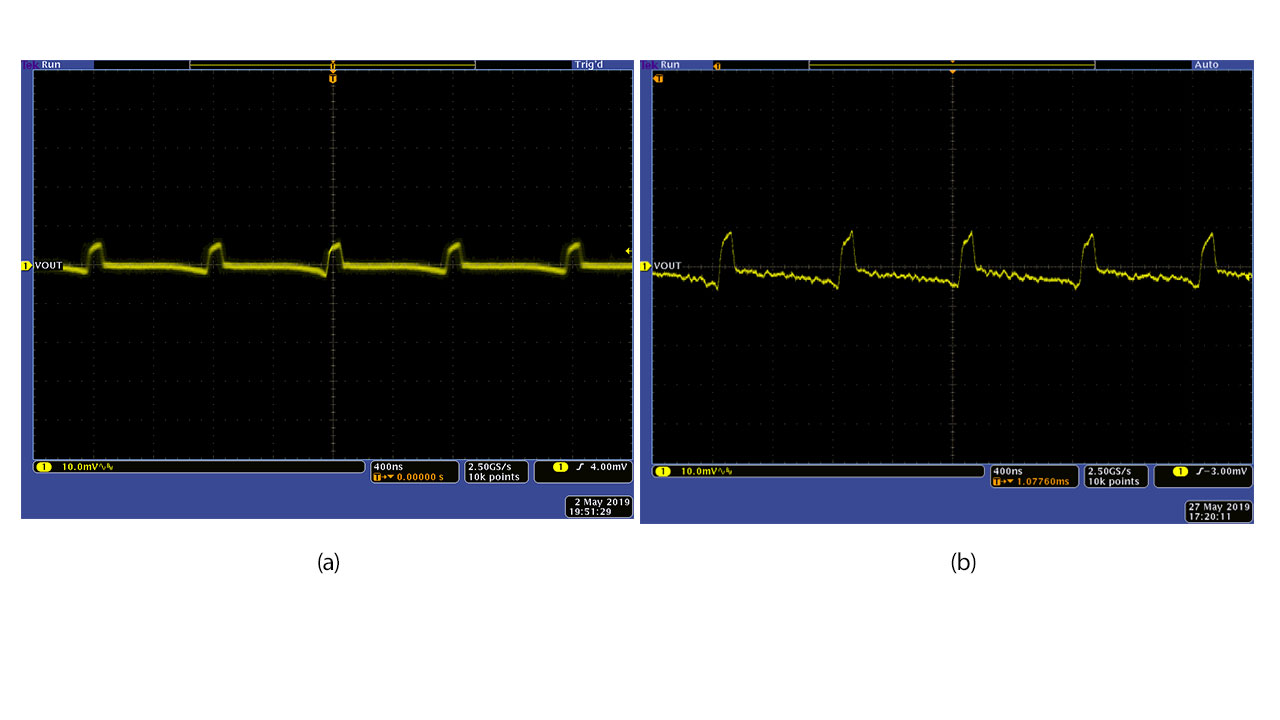 Figure 5 Output Voltage Ripple of
the TPS518215EVM with Four MLCCs in Parallel (a); One Aluminum Polymer
Capacitor in Parallel with One MLCC (b)
Figure 5 Output Voltage Ripple of
the TPS518215EVM with Four MLCCs in Parallel (a); One Aluminum Polymer
Capacitor in Parallel with One MLCC (b)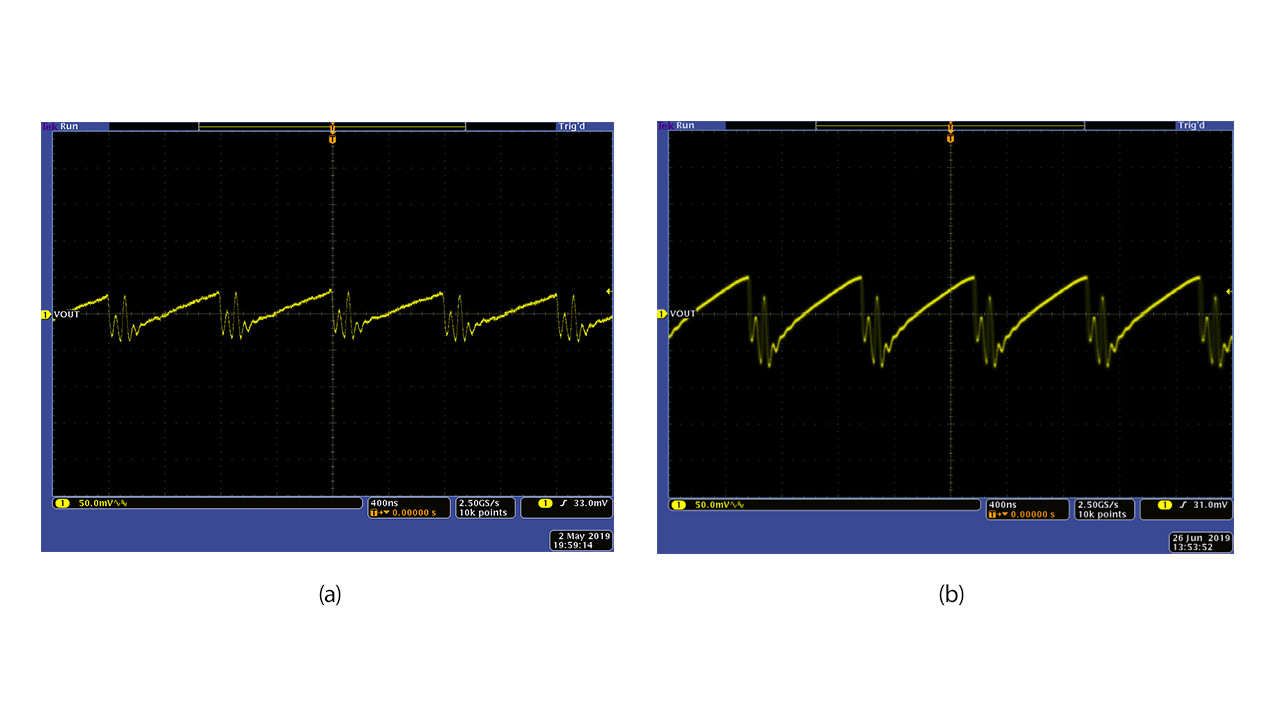 Figure 6 Input Voltage Ripple of
the TPS518215EVM with Six MLCCs in Parallel (a); One Aluminum Polymer
Capacitor in Parallel with Three MLCCs (b)
Figure 6 Input Voltage Ripple of
the TPS518215EVM with Six MLCCs in Parallel (a); One Aluminum Polymer
Capacitor in Parallel with Three MLCCs (b)As I’ve shown in this article, one way to reduce the count of MLCCs for DC/DC switching regulators is to replace some of them with aluminum polymer capacitors. Needless to say, you will need further tests to check that the performance of this hybrid capacitor configuration still fits within your design requirements. Every capacitor has its own characteristics and every design has its own requirements, but this alternative is definitely something to keep in mind while MLCCs are in short supply.
Additional Resources:
- To find out how to select a device capable of operating with fewer external capacitors read the technical article, “Minimize the impact of the MLCC shortage on your power application.”
- To consider other alternatives to minimizing MLCC count read the technical article, “Minimize the impact of the MLCC shortage using D-CAP+™ control mode.”